With abundant golden temples and statues encrusted with gems, Thailand is recognized worldwide as a colored gemstone hub. The country has always been considered at the forefront of jewelry and gemstone production and exportation.
And here are the reasons why it is so well known among gem traders all over the world and why you should consider buying Thai gems and jewelry on your trip to this tropical country.
History of Thai jewelry and gems
The custom of excellent craftsmanship for jewelry and gems in Thailand has passed down through many generations and is still intact to this day.
In Thai, the jewelry and gemstones industry is one of the leading industries and has thrived since ancient times.
Ruby mines in Thailand
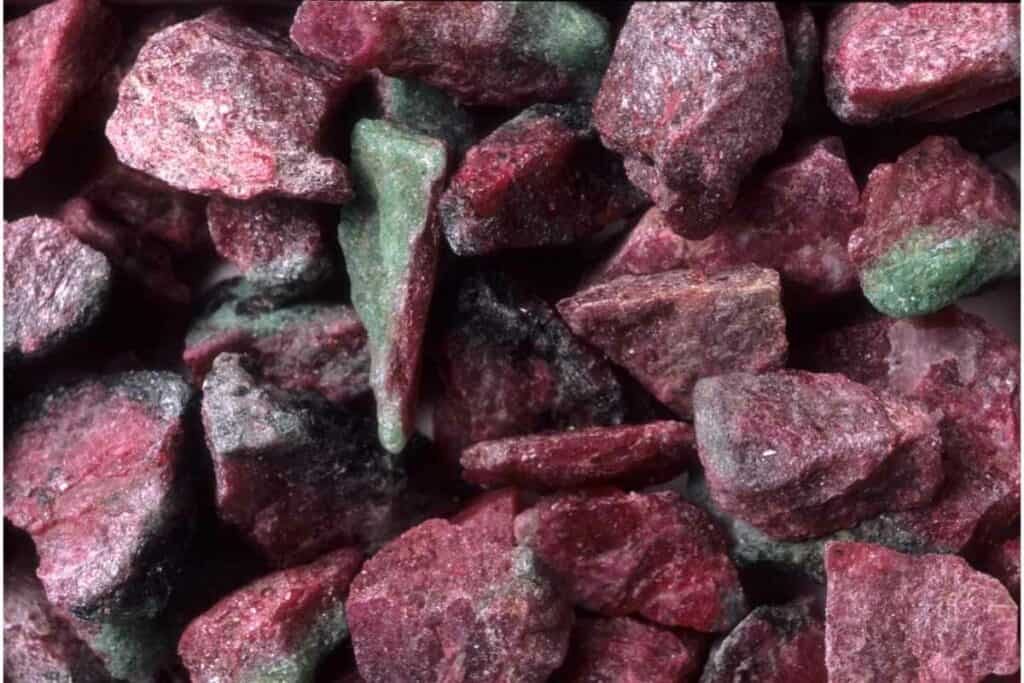
With a history dating back to the 15th century, Thailand was an important mining industry country.
The primary mines were located in Trat, Kanchanaburi, and Chanthaburi regions, where rubies and sapphires were mainly found. However, the rubies mined from Thailand were considered inferior to Myanmar’s ‘Pigeon’s Blood’ rubies, as Thai rubies have a darker color due to extra iron.
However, in the 1960s, Myanmar mines were controlled by the socialist U Ne Win government after a coup in 1962, and the market had to switch to an alternative source.
This opened the market for Thailand jewelry, as the market searched for an alternative source of rubies. Also, Thai dealers had found a way of heating the gemstones to improve their color. (This was the main reason Myanmar’s ‘Pigeon’s Blood’ rubies were considered superior to Thailand’s.)
With these two significant developments in the market, Thailand’s rubies became a massive success to the point that the 1980s almost depleted the mines in the country.
But the country has shown its skills in cutting and treating the gems and has been able to secure its position in the industry since then. (Source)
Gold
The history of Thai gold jewelry goes way back thousands of years.
Did you know?
Thailand’s original name ‘Siam’ means ‘gold’ in the Sanskrit language; the Indians called the country ‘Suvannabhumi’ or ‘Land of Gold,’ and the Chinese called it ‘Jin Lin’ which means ‘Peninsula of Gold.’
In Thai, gold jewelry trading was also probably what gave the country its first contact with the outside world.
It has been said that gold craft traveled to Thailand around 2000 years ago through Hindu settlers from the east and south of India. Their techniques were picked up by the Dvaravati Mons of Chao Phraya Basin, who heavily influenced the craft in the rising civilization of Khmer.
During the Srivichai era, goldsmiths were able to make gold foils to use in Buddhist ceremonies, and of the gold ornaments made during that time, gold beads were known to be made in the southern and the central regions of Thailand.
Meanwhile, in the Sukhothai period, gold was beaten into thin, flat sheets to cover Buddha statues, and by then, goldsmiths also found out how to goldplate giant Buddha statues. Gold ornaments during the Sukhothai period were simple, smooth, and had minimal designs.
The tradition of gold and gem-based jewelry peaked during the Ayutthaya era – the rulers would commission gold crowns, swords, and even footwear embellished with various glittering gemstones.
Gold was also an essential part of constructing Buddha temples and Buddha statues during that time. It was to the point that the Ayutthaya period was considered the “Golden Age of Gold.” (Source, Source)
Usage of gold in religion
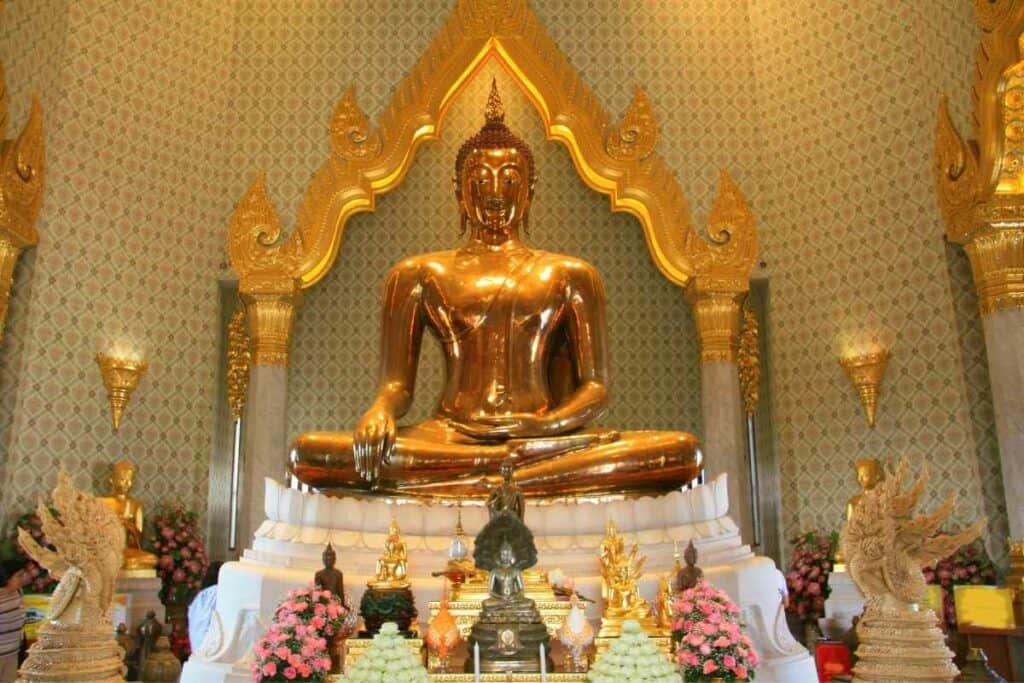
In Thailand, gemstones and jewelry are used for more than just aesthetic purposes. Gold, in particular, is used on many occasions, such as for religious purposes.
For many Thais, gold has a great religious significance in Buddhism as the Buddhist literature described the Buddha as having the skin of gold.
For this reason, many Buddha images in Thailand are made of gold, and as part of religious rituals, gold leaf is also stuck onto Buddha images. The largest Buddha image in the world is housed at Wat Trimitr in Thailand. Known as the Golden Buddha, it is made with pure gold and weighs over 5 tons.
Gold is also commonly used to make Thai amulets, a Thai Buddhist blessed item. Many Buddhist Thai people wear or carry amulets with them. It is believed that these protection amulets or “good luck charms” can be very powerful in many forms of spirituality.
These amulets are believed to have the ability to heal, protect and balance the owner’s energies.
Almost every Buddhist Thai owns at least one amulet, and many use them to improve their wealth, health, marriage, and relationships. (Source, Source)
▸ READ MORE about ▸ Thai Amulets
Hill Tribe Silver
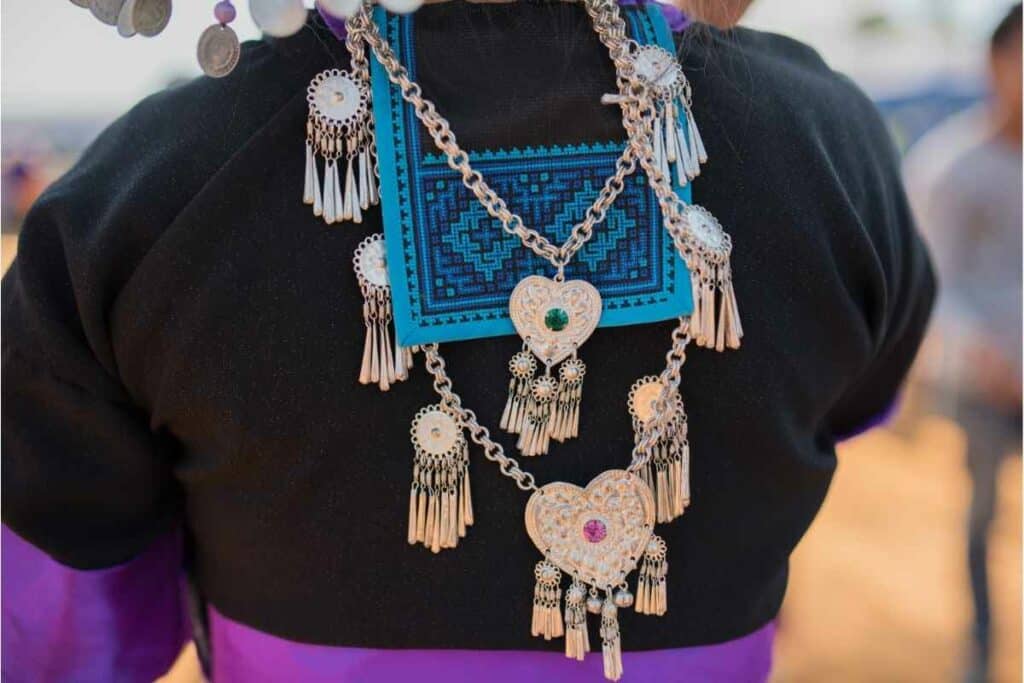
Thai hill tribe silver is perhaps the most famous of all Thai jewelry. Known for its beautiful tribal and nature motifs, Thai hill tribe jewelry has been crafted for generations by the hill tribes in Thailand, the largest of these hill tribes being the Karen/Kayan hill tribes.
At first, hill tribe silver jewelry was reserved only for the tribes’ use as these pieces of jewelry symbolize social status and affluence among the tribe people. It didn’t become a major trade until the mid-to-late 20th century in Thailand.
Karen hill tribe’s silver jewelry is now famous worldwide for its hand-made designs – from beads, clasps, pendants, and earrings to classic designs.
Thai silver jewelry is also known for its high content in silver, as its purity range between 95% to 99.9%. Karen artisans combine a bronze alloy with silver to create a robust soldering solution to keep the silver’s luster intact. (Source)
▸ READ MORE about ▸ The Long Neck Tribe
Silverware
Influenced by the early Hindu culture, silverware in Thailand was initially confined to use only for items of ritual worship and ceremonial uses.
About seven centuries ago, silver tooling became a prominent craft – partly due to the skillsets brought into Thailand by refugees from Myanmar. Eventually, this led to the development of a distinct style (known as Thai silverware today). It gradually evolved as the Thais migrated to southern regions. (Source)
Quality of Thai gem jewelry and craftsmanship
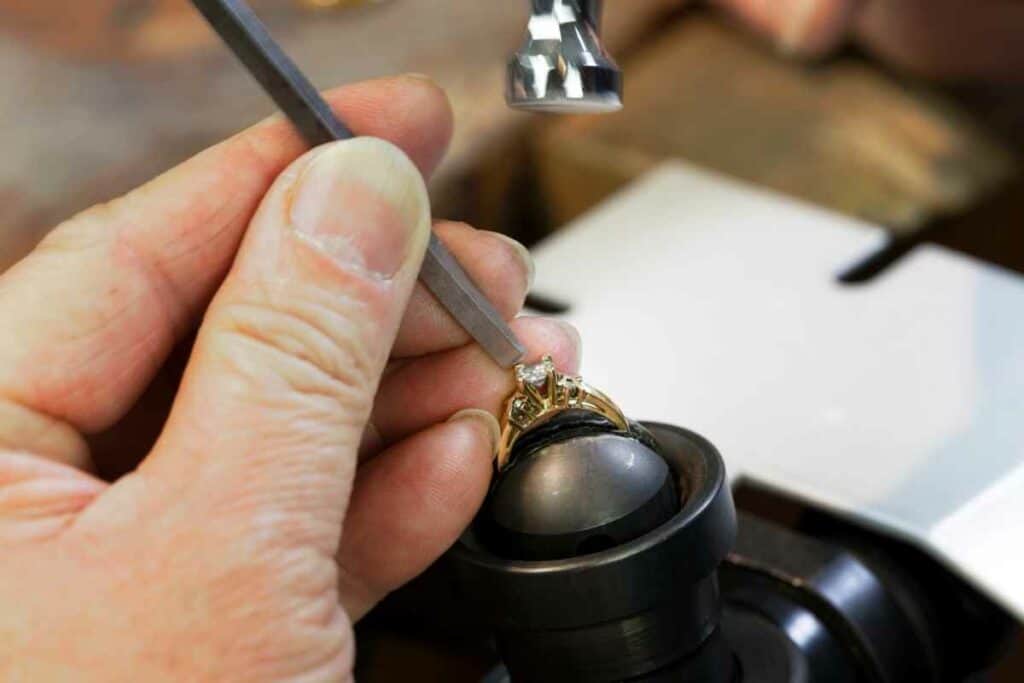
The range of gemstones that can be obtained in Thailand is diverse – including ruby, diamond, sapphire, etc.
Quality assessment
The values of Thai jewels are guaranteed, and the selling of gemstones and jewelry in Thailand is managed by trading policies to ensure quality.
Globally accepted local organizations such as the International Gemological Institute (IGI), Gems and Jewelry Institute of Thailand (GIT), and others – evaluate and assure the value of Thai gem jewelry.
Craftsmanship
Thailand is known for its gemstone craftsmanship too.
Thai artisans pride themselves on the long history of uniquely handcrafted artisans found everywhere – from the theatres to the temples.
Thailand’s standout point in the industry is the incomparable level of expertise in processing rough, colored gemstones supported by cutting-edge technologies.
Heat treatment:
One particularly known technique Thai craftsmen used is the ‘heat treatment.’ When the gems are heated at a specific temperature, they become more translucent and vivid, and it can even heal the cracks inside the stones sometimes.
Some version of the technique involves only heat. An imitation of the phenomena that naturally form the colored rocks in the first place, while some versions add other components such as sand, glass, and chemicals.
Thailand is one of the few countries that have perfected this ‘heat treatment’ technique. And as for the story of how Thailand developed such a method, some say that it was discovered by accident.
In 1968, a big fire destroyed the gem market in the Chanthaburi region, considered the gem city of Thailand.
After the fire, many shop owners were surprised to see that their gemstones were not only undamaged but also were even more beautiful than before.
Therefore, the Chanthaburi’s gem traders began experimenting. As a result, they discovered this unique technique that can highlight the beauty of colored gemstones.
Lapidary:
Aside from this heating technique, Thailand is also internationally known for its lapidary.
The lapidary enthusiasts from Thailand had a lot of opportunities to sharpen their skills since they started when rough stones were rich in the country and were distributed at a much lower price.
The experience taught them to find the best approach for each gem – choosing which side and which style to cut to get the best possible version of the stone. As a result, Thai craftspeople became experts in this field.
To this day, Thai artisans are praised worldwide for their ability to create beautifully balanced and symmetrical gemstones by using only hands and relatively simple tools.
Specific expertise:
Each region of Thailand also has its specific expertise. Chanthaburi and Kanchanaburi are famous for colored gemstone processing and jewelry design.
At the same time, the northern part of the country, especially Chiang Mai, is known for having a variety of techniques for making silver jewelry.
Meanwhile, the southern Thailand regions, such as Ranong, Phangnga, and Phuket, pride themselves on jewelry adorned with pearls.
Sukhothai region also has a long history of gold jewelry with its unique and intricate designs. (Source)
Internationally recognized standards
Standard verifications are particularly important in craft-based industries, such as gems and jewelry.
Consequently, Thailand invests a lot to ensure that its gems and jewelry are eligible for internationally recognized standards. The country’s primary focus is on the testing laboratory, a part of the industry’s ecosystem that is directly concerned with the standardization process.
Gems and Jewelry Institute of Thailand (GIT) issues reports for various gemstones found in Thailand. Identifying Thailand jewelry is done inside their gem testing laboratory, which professional gemologists operate. GIT’s laboratory was certified by The World Jewelry Confederation (CIBJO) in 2000, and at present, it can verify the quality, origin, and characteristics of gemstones, silver, gold, and pearls.
GIT’s laboratory has the reputation of being one of the seven best gem testing labs globally – ensuring the quality of Thai gemstones and jewelry. (Source)
Thailand’s jewelry market
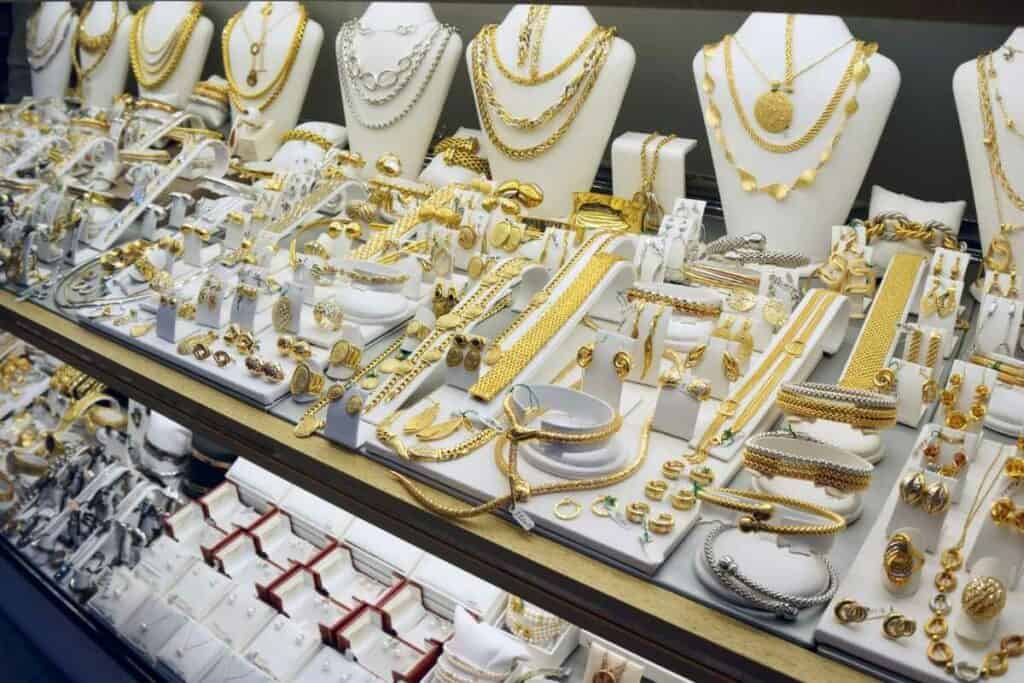
With a long history of expertise, Thailand’s industry is growing as a global hub for gemstones and jewelry trading.
While it may surprise some, a massive portion of jewelry in many countries such as the US, the EU, Hong Kong, Japan, and the Middle East is from Thailand. Thailand is the world’s 3rd largest colored stone exporter and also the world’s largest silver jewelry exporter.
In 2019 alone, the country produced 50,000 metric tons of silver. The average revenue of Thailand’s gem and jewelry industry is nearly one trillion THB, and over 18,000 workers are in the upstream gem and jewelry industries nationwide; for mining, gemstone cutting, and polishing.
The export value of Thailand’s gems and jewelry products also reached the highest rank for the first half of 2020, at more than 10,000.00 million USD.
To keep the country’s competitiveness in the industry, the government and entrepreneurs in Thailand have been investing in new technologies and marketing activities to keep the business afloat.
Thailand’s government has introduced many policies to encourage the industry’s development, such as granting a duty exception for importing raw materials and giving tax benefits for jewelry products.
In September 2020, GIT set up GIT Gems and Precious Metals Standard – aiming to upgrade the gem and metals testing private laboratories or purchasing and QC laboratory sections of jewelry factories in Thailand.
GIT also collaborated with local gem trader associations to promote colored stone trading by issuing product quality certificates under GIT’s “Buy with Confidence (BWC)” project. This project boosts the buyers’ confidence and helps the trading process to become more accessible.
Chanthaburi city is also being pushed by the local entrepreneurs and alliance agencies of GIT as the ‘City of Gems’ with plans to organize annual trade fairs similar to the Tucson Gems Show in the US. (Source, Source)
3 Best Thai jewelry brands you can buy online
Among the famous Thai jewelry designers, here are some of the most recent standout ones, known globally for their designs and creativity.
These Thai jewelry brands also can be purchased online, making them ideal for those who are not in Thailand right now:
1. SARRAN by Sarran Youkongdee
Sarran Youkongdee founded this jewelry brand in 2008 based on the concept of Asian elegance and blending the Thai heritage with the concepts of emotions and stories.
The origin of the SARRAN brand aims to become the “connection right between” the core value of Asian women and Sarran Youkongdee’s sense of creativity and to create beyond exceptional jewelry pieces, which are known as ‘Art-To-Wear.’
Sarran’s jewelry pieces are characterized by flowers and an artistry that pays homage to women from all over the world. The brand has also achieved local and international recognition. Sarran Youkongdee became the first Thai to be awarded the LOOT Acquisition Award Winner 2018 by the Museum of Arts and Design, New York.
SARRAN’s jewel collections include buckles and belts, earrings, ear cuffs, bangles, and hairpieces- flowers and stories characterize all. (Source, Source)
| Website | https://sarranofficial.com |
| https://www.instagram.com/sarranofficial/ | |
| Where to Buy Online | https://linktr.ee/sarranofficial |
2. Pattaraphan
This Thailand-based, unisex jewelry brand is loved by big-name celebrities like Gigi Hadid, Bella Hadid, Hailey Bieber, and Kendell Janner.
The designer and founder of the Pattaraphan brand, Pattaraphan Salirathavibhaga, or Nok as her nickname goes, started the brand after noticing a gap in the Thai market for high-quality jewelry that is accessible edgy, and contemporary.
At that time, the ones already available in the market were either expensive traditional Thai jewelry pieces or mass-produced Thai fashion jewelry.
Inspired by her heritage and the idea that “jewelry should feel good on the skin” and “should be a natural extension of oneself,” Nok creates unisex jewelry pieces committed to preserving Thai heritage.
The bold designs of Pattaraphan jewelry pieces pay homage to the brand’s Thai roots.
For example, Nok took inspiration from older generations of Thai ladies wearing pearl jewelry necklaces to formal events and created chain necklaces, hoop earrings, silver bracelets, and more in her ‘CO’ collection.
Nok said that Pattaraphan’s jewelry is produced in small batches by local Thai artisans who have been in the gems and jewelry for decades.
Her genderless, unisex designs are receiving much love, both locally and from overseas, and British Vogue even called her brand a “must-have item for every IT girl.” (Source, Source, Source)
| Website | https://pattaraphan.com |
| https://www.instagram.com/_pattaraphan_/ | |
| Where to Buy Online | https://anotherstorybangkok.com/collections/pattaraphan |
3. Kin.Ko
Good news for international jewelry lovers – this brand offers a worldwide shipping service!
It was created by two sisters, Kacha & Rada Koranee, Kin.Ko is a contemporary jewelry and lifestyle brand of luxury pieces handcrafted by local artisans in Bangkok, Thailand.
The brand is meant to allow everyone to celebrate their individuality and is designed to complement and be suitable for individuals of all genders.
What’s unique about Kin.Ko’s piece is that every jewelry piece has beautiful words engraved in Thai- such as ‘yes, she can,’ ‘be kind,’ as a positive reminder the wearers can keep close to their hearts.
The founders said they are inspired by arts and various beautiful things they get to see, feel and experience in their everyday lives. Another selling point for Kin.Ko is their ‘Good Soul Mission’ project.
The brand emphasizes environmental sustainability, and as a result, they reduce plastic waste as much as possible and source from small local businesses and communities.
As for the packaging, Kin.Ko only uses recycled cardboard boxes and biodegradable paper wraps as well.
Partial of the profits earned are also donated to empower youth and support under-developed schools and communities in Thailand.
Kin.Ko’s collections range from necklaces and rings to bracelets and chains- staying true to their idea of creating jewelry pieces suitable for every individual. (Source, Source)
| Website | https://kinkostore.com |
| https://www.instagram.com/kinko.store/ | |
| Where to Buy Online | https://linktr.ee/kinko.store |
How to buy gems and jewelry in Thailand
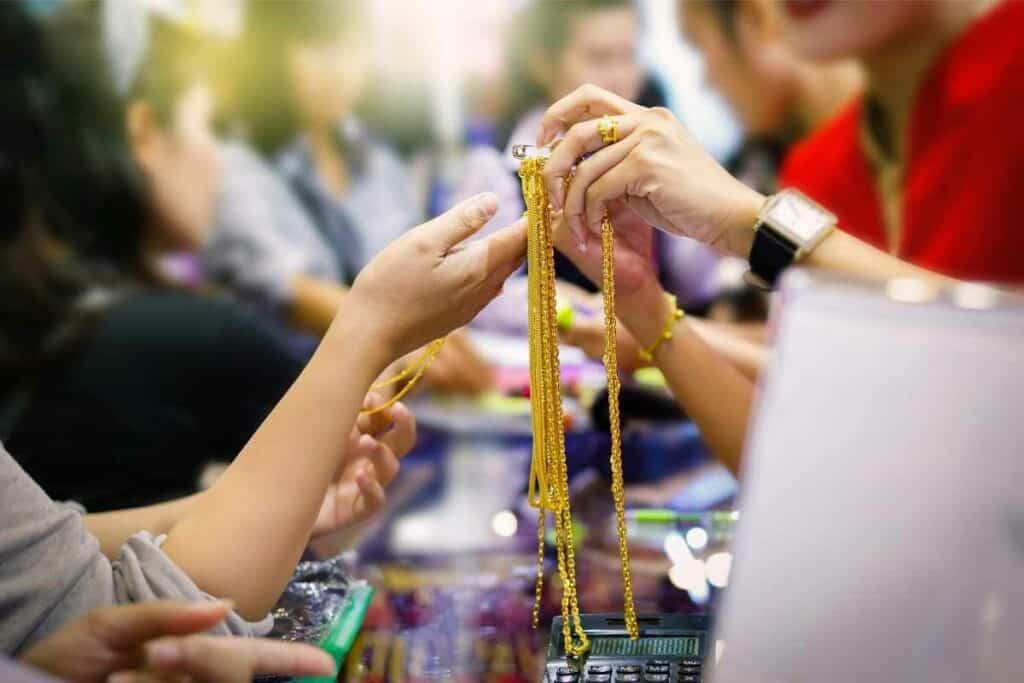
If you have plans to purchase gemstones and jewelry on your trip to Thailand – worry not!
Once you have landed in Bangkok, the Jewelry Trade Center (JTC) in the capital’s Central Business District is the place to go.
Located on the Silom Road of Bangkok, JTC is a well-known spot among Thailand jewelry manufacturers and worldwide due to its competitive prices.
More than 1,500 wholesalers and 300 Thai jewelry stores are operating inside the building, making it Thailand’s most prominent marketplace for gems and jewelry trade.
The only downside of the JTC building is that it is too big to the point that it is difficult to find a starting point to search for your desired product. However, it is a very tourist-friendly place.
Once you fill in the form at the reception counter on the ground floor, you will get a free shopping bag or birthstone. Complimentary personal shopper service is also offered to make your shopping spree easier and more enjoyable.
And the best part is that JTC supplies everything – from fine jewelry to Thai designer products, from silver to Thai diamond jewelry, and from traditional Thai jewelry pieces to one-of-a-kind customized designs. (Source)
3 Useful tips on how to buy Thai Jewelry
And here are a few tips for first-time buyers to ensure you get the most bang out for your buck:
1. Find a trustworthy seller
New buyers may have a common question about Thailand’s jewelry market: “is jewelry made in Thailand real?’
It may be obvious, but do not get swayed by the people on the street who approach you and push you to buy their jewelry. Sometimes, the taxi drivers or the Tuk-Tuk drivers might take you to overpriced jewelry shops and persuade you to buy there but never purchase gems from places you do not know beforehand.
Instead, buy from the businesses that even wholesalers trust.
2. Check for certificate
As mentioned above, GTI has a ‘Buy with confidence’ project to reassure anyone who wishes to buy gems in Thailand.
The guarantee comes in stickers and tags with BWC’s logo on them. Also, a QR code that provides the details of both the products and the shops.
To avoid fraud, you should always check for BWC logo marks before buying any gems and jewelry in Thailand. Also, you can check if the Thai jewelry is authentic (and the origin of the gemstone) at GIT and the Asian Institute of Gemological Sciences.
Both are located inside the JTC building or at the Tokyo Gem Laboratory, which is 10 minutes away from the JTC building by foot.
3. Don’t forget to bargain
It is common for foreigners to be told higher prices than the original while buying from small sellers. Sometimes, they might ask for 50% more than the actual price when selling to foreigners.
To avoid this, it has been advised to ask for the wholesale price to get a reasonable quote and then negotiate from there. This won’t happen with more significant sellers and companies as they usually have fixed prices, but it makes it a bit easier to negotiate a better price. (Source)
Conclusion
As the country is recently opening to foreign visitors and tourists again, the Thai jewelry industry strives to improve technology, assurance, and sustainability issues.
With a long history of expertise and beautifully handcrafted jewelry made in Thailand, the country is becoming Asia’s hub for jewelry trading.
So, next time you think about buying gemstones or jewelry, Thailand and Thai jewelry brands are worth considering.
Like always, if you want to discover more about Thailand, stay guided by ThaiGuider. You might learn something you never knew about this unique country.
▸ CHECK OUT our Complete Guide on ▸ Thai Culture
THINKING ABOUT A TRIP TO THAILAND?
I am working on a FREE Thailand Travel Guide with a FULL 7 Day Itinerary. Be the first to receive it!
Thank you for signing up.
Something went wrong.
